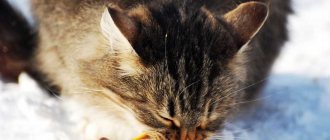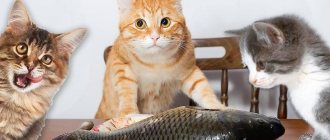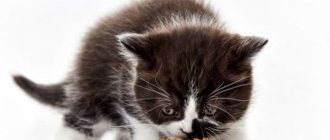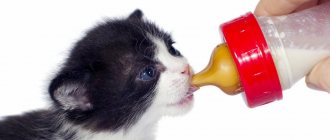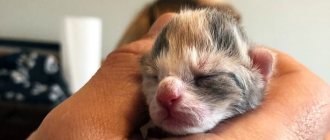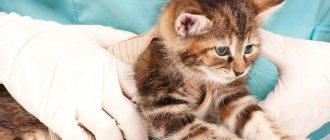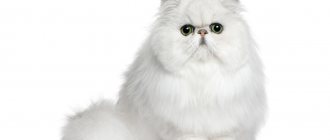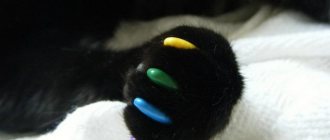Recently, the phrase “a cat is an obligate predator” has often been heard. And it is true. Cats are not omnivores. But if you think that a predator needs to be fed meat, then you are deeply mistaken. Eating pure meat leads to serious health problems due to an imbalance of minerals, primarily calcium and phosphorus, and a lack of vitamins. Meat is an excellent source of complete protein, but otherwise it has a poor composition. Therefore, offal for cats is not a delicacy or pampering, but a necessary component of the diet.
The secret to the survival and relative well-being of the wild ancestors of the domestic cat was eating the prey whole. Usually it is a small rodent or bird. In addition to meat, the cat receives bones and cartilage, fatty brain, stomach and intestines with all contents, liver, kidneys, lungs - in other words, all internal organs.
Cats eat whole mice
Feeding offal in addition to muscle meat allows you to balance the cat’s diet without numerous vitamin and mineral supplements. Another advantage is that by using different by-products, you can easily play with the calorie content, reducing or increasing the nutritional value depending on the pet’s needs.
At the same time, you need to carefully feed the internal organs of various animals to your cat, taking some precautions. In the article I will talk about what by-products to give to your pet and in what quantity, so that the benefits from them outweigh the possible negative consequences. Author of the article: Olga Shiltsova, practicing veterinarian, author of the books “Dachshund of Fate” and “Tails of Fortune”
How often to give your cat by-products, and in what quantity?
The share of by-products in the diet is calculated depending on their type. Muscular organs - the tongue, heart, gizzard of the bird - are given as part of the “meat” part of the diet, the total share of which is about 70%.
Internal organs (liver, kidneys, lungs, brains, spleen) provide 10-15% of the total diet. Another 10% should come from bones. Their sources are rabbit or poultry ribs, chicken necks and heads, and quail frames. The share of meat and bone ingredients is about 20%.
Chicken neck for a cat
If the cat has not eaten offal before, it needs to be introduced to it gradually, starting with microscopic quantities. When switching from dry food to natural food, the cat is first fed muscle meat, and then they begin to give various by-products, monitoring the pet’s individual reaction.
A variety of by-products is good for your pet
Muscle by-products can be fed to your cat daily, and some are fed 1-3 times a week to add variety to the diet. If, in response to feeding the internal organs, the cat's stool becomes thinner, their quantity is sharply reduced and the digestive tract begins to re-acclimate, gradually increasing the volume to the desired level.
Next, we will take a closer look at some types of by-products and their optimal quantity.
Types that can be given to a cat
Research by felinologists on the selection of the optimal diet for cats identifies the following types of offal from different animals:
The most useful product for your pet will be beef.
- Cows. Giving beef liver is very useful, as it contains the optimal amount of proteins, fats and vitamins.
- Chicken. It is possible to feed your cat chicken liver, but it contains fewer nutrients than cow liver and also contains more fat. There is a risk of gastrointestinal upset.
- Piglet. Pork liver is very harmful, as it contains high amounts of fats and toxic substances. Veterinarians do not recommend including it on the menu. Raw food is strictly prohibited.
- Ray-finned fish. Cod liver is rich in vitamins and polyunsaturated acids, but it should not be given to pets due to its high fat content.
By-products for cats are the only source of calcium
The most common mistake in natural feeding of cats is a violation of the ratio of calcium and phosphorus in food. For adult animals, the Ca:P balance should be approximately 1.2-1.7:1, for kittens 2:1. At the same time, most products, including meat, contain much more phosphorus than calcium.
The only chance to enrich the natural diet with calcium is to feed your pet not only meat, but also bones. To do this, chicken necks and heads are introduced into the diet.
Chicken heads: Cat's dinner can look creepy
Depending on the size and habits of the cat, chicken necks give:
- Entirely;
- Cut into pieces;
- Scrolled through a meat grinder as part of a meat mix.
Whole, sliced and twisted chicken necks
The hard and sharp beak is cut off from the chicken heads, and the heads themselves can first be beaten with a hammer.
Rules for feeding cats with bone by-products:
- Bones are given ONLY IN RAW FORM. Boiled bones are dangerous for cats.
- Bones should make up about 10% of the diet, which means 20-30% meat and bone ingredients.
- If the cat's feces become dry, white, or bowel movements are irregular (constipation), bones are excluded from the diet or their quantity is reduced.
- They only give spongy bones, not tubular bones (legs and wings are not allowed).
If you are afraid to give your cat bones or she cannot eat them for health reasons (diseases of the gastrointestinal tract, lack of teeth, etc.), calcium should be added to the diet in the form of commercial veterinary supplements.
Why is the raw product dangerous?
Cats digest raw meat best, but there are two dangers when consuming it:
- Worms. The meat may contain helminth eggs. These parasites poison the animal’s body, often damaging its internal organs, and if severely infested, lead to intestinal blockage. Without timely treatment, the cat may even die.
- Bacterial infections. If meat is sold from an open market stall, flies may land on it and carry the disease. Shopping in such places should be avoided so as not to harm your pet.
By-products to increase calorie intake
Some parts of the carcass contain woefully little protein but are high in fat. And some, such as testes, are a source of protein and fat at the same time. Fatty by-products should not be given to cats with impaired liver or pancreas function, as well as animals prone to obesity. But they serve as an excellent energy boost, for example, for nursing cats or stud cats.
Testes (bovine, lamb)
Although the seeds are considered a delicacy in many cuisines around the world, they are quite difficult to find for sale. They don’t have to be included in your cat’s diet for it to be complete, but if the opportunity arises, be sure to let your pet try them.
Beef testes
The testes contain a lot of protein and fat, B vitamins and microelements (zinc, manganese, copper, nickel).
There is no need to be afraid of the hormones supposedly contained in the testicles. Their concentration in the testes is negligible, since all produced testosterone immediately enters the blood.
The testes are given raw or lightly boiled (7 minutes after boiling). Before giving them to a cat, remove the thick shell from the testicles and cut them into pieces. The norm is 5-10% of the diet, while it is permissible to feed the testes in a separate feeding, without mixing them with meat.
Beef udder
Udder is a cheap and nutritious product, but I recommend feeding it to cats with caution. The dry udder consists mainly of fat and rough connective tissue, which is difficult to digest. The milk udder has a more delicate consistency and a pleasant sweetish milky smell and taste. But cows are rarely slaughtered for meat during lactation without a good reason; usually these are sick animals. Therefore, the milk udder must be carefully checked for signs of mastitis (pus, inflamed areas).
The udder contains about 12% incomplete protein and 14% fat. It is given to cats in order to increase the calorie content of the diet, in an amount of no more than 5% of the total diet. This product is fed both raw and cooked (the broth after cooking is not used for feeding). The udder has a rubbery consistency, it is very difficult to chew or bite off a piece, so you need to cut it into convenient pieces in advance. The easiest way to cut a frozen product is to use a very sharp knife.
Brain
Beef brains can be difficult to find commercially because they are perishable. But if you give your cat chicken heads, then when she eats them, she also gets brains. The value of brains lies in the fats they contain. These are omega fatty acids, lecithins and cholesterol. The brain also contains a lot of choline (B4).
Beef brains, if you were able to buy them, are not fed in their pure form, but are added to the meat mixture. The high fat content of this offal causes severe diarrhea in cats if the dosage is overdone. Brains are given in the amount of 2% of the total diet. They can be especially useful for cats exhausted by pregnancy and lactation, as they increase the calorie content of food.
Why is pork banned?
Any sane person understands that prohibitions do not appear out of nowhere. Pork is no exception; the bad reputation of this product, unfortunately, was justified by facts. There is no need to be afraid, since all threats can be avoided with a reasonable approach and sufficient awareness.
Never buy meat (any kind) at spontaneous markets. For some reason, people get the impression that if it’s bought secondhand, it means it’s homemade and of high quality. In fact, spontaneous traders very often neglect the standards for raising animals, vaccinations, and requirements for storing meat. Particularly enterprising traders buy carcasses from industrial farms and sell them as domestic ones.
Supermarkets often resort to tricks to make stale meat look fresh. For example, meat is dyed after being kept in a saline solution. After processing, the products look lush, heavy, beautiful... and inviting, despite the significant delay. You may come across promotions such as pork marinated or packed in sealed bags. Don't give in! The marinade helps eliminate the smell of rot! A sealed bag is a way to hide odor and compress meat to give it a more marketable appearance. Please note that lost meat in a vacuum is a rich and very fertile breeding ground for all possible bacteria.
Lungs - is it worth giving them to a cat?
One of the most useless beef by-products is lung. It is made of connective tissue and is difficult for cats to digest. In many animals, eating “airy” offal causes vomiting. Therefore, it is given in small quantities and in combination with meat or other organs.
Beef lung
It is quite possible to create a complete diet without using lungs, but if the cat likes their taste, they are fed in a volume of 5-15% of the diet. The peculiarity of this by-product is its low calorie content, which can be useful when preparing a diet for overweight animals.
If you cut the lung into small pieces and dry it in the oven, you will get an excellent delicacy. It is given to cats between main feedings.
Flaws
- Liver contains a potentially toxic amount of vitamin A that can cause cat poisoning. If your pet loses appetite and weight, limps, feels weak, suffers from constipation or allergies, consult a doctor immediately and be sure to mention that your cat has recently eaten liver.
- Raw liver can be contaminated with bacteria, particularly salmonella. If parasites enter the pet's body, the following symptoms appear: high fever, lack of appetite, vomiting, diarrhea.
The main dangers of pork
What dangers could your cat face when consuming this meat product? There are problems, and serious ones. Unfortunately, pigs themselves are susceptible to many dangerous diseases. In order to get sick, your pet only needs to eat raw meat from a sick animal.
Pork is quite a fatty product, this should also be kept in mind. Finally, many cats are diagnosed with individual intolerance to pork and experience allergic reactions.
Trichinosis
As for trichinosis, it is a very dangerous infectious disease. Infection mainly occurs through eating raw meat. In the last century, this was a real scourge for both farmers and veterinary services. Thank God, thanks to the effective system of measures adopted, the risk of purchasing contaminated meat is minimal. If you want to treat your pet to raw pork, purchase products intended for human consumption and only from trusted places. Never experiment with game - wild boar, elk, bear meat, etc.
Doctors say that trichinosis can be treated well with the same medications as roundworms. True, Trichinella larvae, which find refuge in muscle tissue, pose some danger.
Trichinella is spread by mice and rats. Be careful if your cat hunts rodents on the street, much less eats them. Then you will wonder for a long time where your pet contracted trichinosis.
Rules for eating pork during lactation
To avoid negative consequences, mother should adhere to some recommendations when eating pork:
- Pig meat should be introduced into the diet no earlier than 90 days after delivery. You should start with broth made from lean pork, you can add vegetables. The broth must be secondary, in which case the content of harmful substances in it is minimal. Over the next two days, observe the baby's reaction. If there is no bad reaction to the soup, you can try introducing meat, starting with 50 grams. If a child experiences an upset stomach or an allergic reaction, then attempting to eat pork should be postponed for a month;
- A nursing woman can consume pork no more than once every 7 days. You are allowed to eat 100–150 grams of pork per day;
- It is recommended to eat pork before lunch;
- For nutrition, you should choose lean pieces of meat. Lard should make up less than 10% of the total share;
- Before cooking, the meat must be thoroughly washed and excess fat trimmed off;
- It is forbidden to eat raw meat or food streaked with blood;
- the product must be subjected to long-term heat treatment;
- the best option for a nursing mother would be steamed pork, baked, boiled or stewed meat;
- fried, smoked, and grilled pork should be limited;
- During lactation, you can eat pork liver, which is well digestible and contains a little fat.
You should start introducing pork into your diet with broth.
